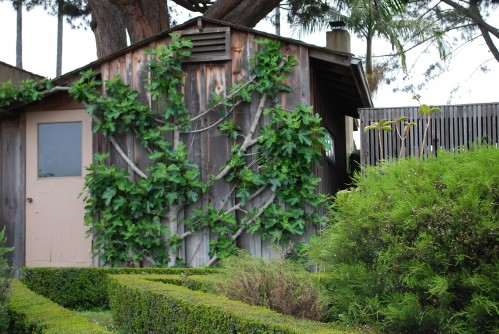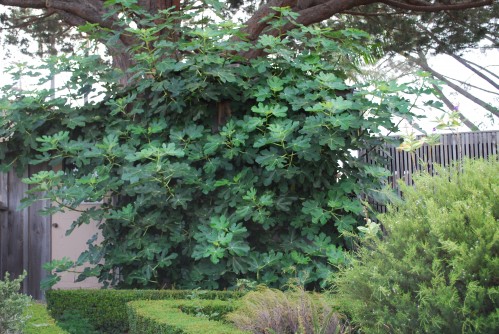 There is a lot of interest in espaliered trees right now. It is an art form, visually attractive, and espaliered trees lend themselves easily to small spaces with high fruit yield. For espalier basics, including how to plant your tree initially and espalier patterns, see related post, The Art of Espalier Fruit Trees.
There is a lot of interest in espaliered trees right now. It is an art form, visually attractive, and espaliered trees lend themselves easily to small spaces with high fruit yield. For espalier basics, including how to plant your tree initially and espalier patterns, see related post, The Art of Espalier Fruit Trees.
I have this wonderful shed in my middle garden that faces west, which I thought would be great to espalier a tree on. I chose a fig tree because they can cover a large area, and architecturally their branches, leaves, and fruit are so appealing.
Winter time, in Southern California, offers the best selection of dormant fruit trees, and is the best time to plant them. I started with a bare root Black Jack fig tree, which was about the size of a standard broom handle. It did have buds forming on its trunk, and that is what you look for. The buds on a dormant fruit tree trunk are the potential cordons or arms that grow out horizontally, and become your pattern.
With an espaliered fruit tree, you are going to need the support of a building or a wall of some kind. Mature fruit trees laden with fruit have some weight to them. See photo below.
How To Create A Fan Espalier Pattern For A Fruit Tree 1) Find your location. It should be a sunny west or south facing spot, year round.
2) Research your ideal fruit tree for your particular spot. The fan espalier pattern is an easy pattern to follow, and can cover a large surface. Some fruit trees lend themselves better to certain patterns than others. Popular fruit trees which are well suited for a fan espalier and informal fan espalier pattern are currant, gooseberry, fig, loquat, peach, nectarine, oriental persimmon, pineapple guava, and pomegranate.
3) Materials Needed: 12 to 14 gauge wire, 9/16″ double-pointed staples for wood fencing, wall mounts for masonry and corresponding equipment for stucco/concrete walls, bare root fruit tree preferably with ample buds on its trunk, compost, shovel, sharp clippers, green garden tape, chalk or marker, wire clippers, pliers and tape measure.
4) Chalk on your building or fence where your bare root fruit tree is going to be located. Measure in 18" increments, starting from the soil level, where each horizontal gauge wiring will go. Implement the gauge wiring horizontally across the width of your building or fence area in the 18" spacing increments. The gauge wiring is secured with 9/16" staples, if it is a wood structure. Now you have your support wiring in place. Plant your fruit tree at your chalked spot.
5) A fan espalier pattern is a basic pattern. On both sides the cordons grow from the fruit tree trunk, and angle upward and outward in a fan shape. Fruit tree buds emerge as shoots which are green, pliable, and delicate. As the fig tree buds begin to grow into shoots and eventually cordons, gently secure them with a bamboo stake and green tape against your building. Using green tape, make sure your bamboo stakes are also secured to the gauge wiring for support. This will train your cordons to stay in place.
6) In the photo above, you can see I persuaded my fig tree to grow above the shed door, too. Eventually, your fruit tree will mature, and become its own support. You can remove the bamboo training stakes and green tape, but keep the wire gauge in place.

7) The photo immediately above, captures the same mature fig tree in full growth in the fall, and laden with ripening figs. I prefer to let my fig tree "go wild", and not prune it back till it is dormant, and leaves have fallen off in the winter. If you wish to see more of your espalier pattern, then you must prune your fruit tree in the summer, and as necessary.
A fig tree has wonderful large leaves that cover quickly your whole espalier pattern in the course of the year. If you planted another type of fruit tree, chances are the leaves would not be as large, and your pattern would be more visible without a lot of pruning. With espalier patterns in general, pruning is a necessary part of keeping the pattern. If you have a smaller building or fence to espalier on, and a different type of fruit tree, you could space your gauge wiring at 12" increments.
To get started, start with a fruit tree that you like, grows well in a fan espalier pattern, and is ideal for your location. Follow the basic espalier fan pattern above. Have patience as your fruit tree begins to grow. It can take a few years to create your mature pattern.
Do you have an espaliered fruit tree in your garden? What kind of fruit tree is it? What pattern is it? Did you espalier it, or did you buy it espaliered? Where did you see your first espaliered fruit tree?
